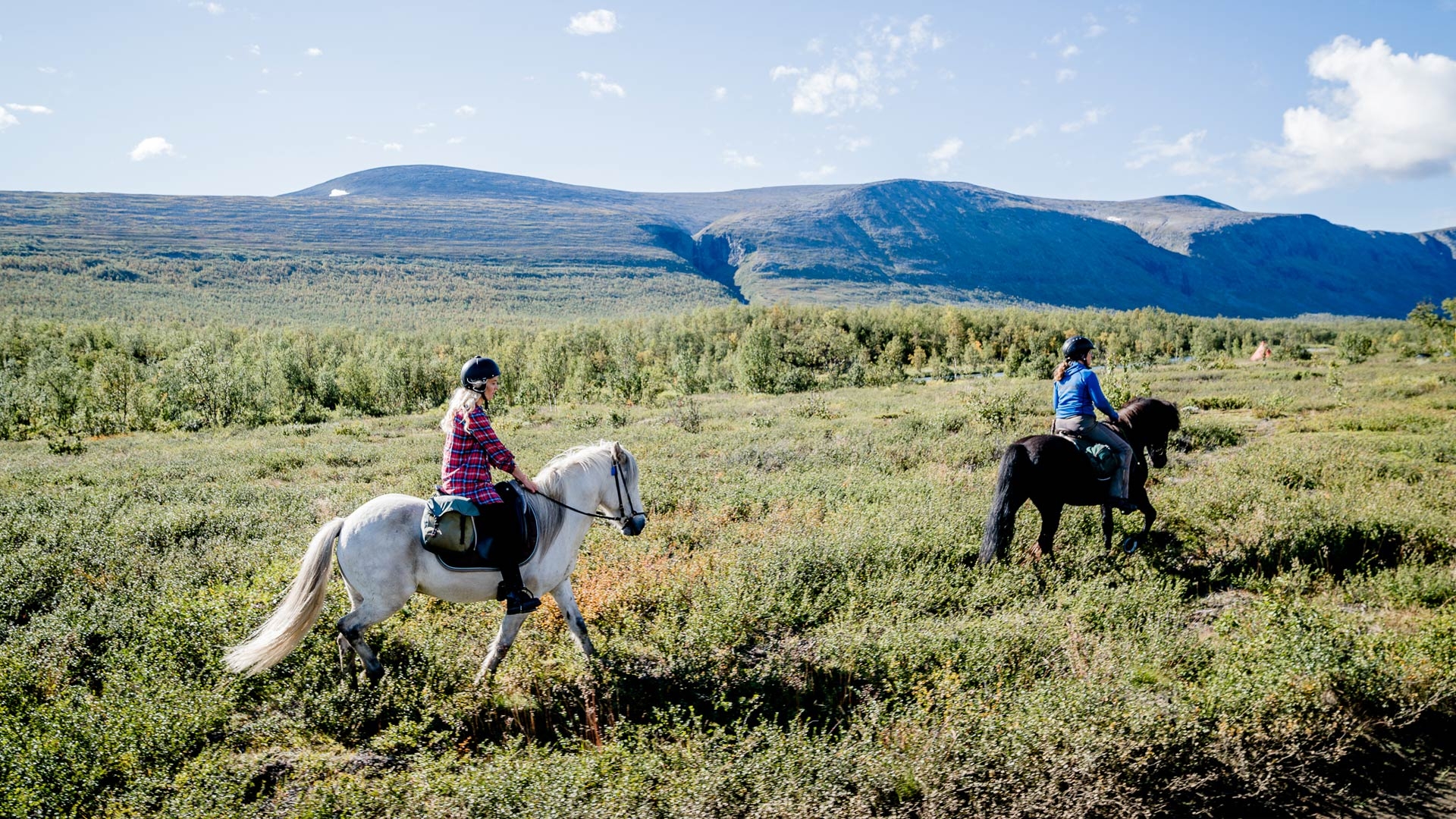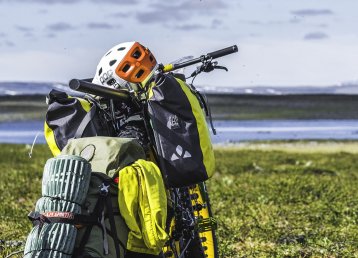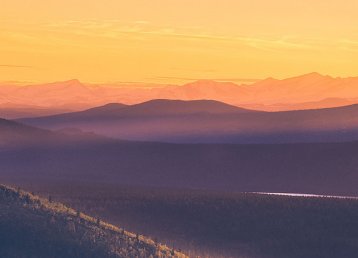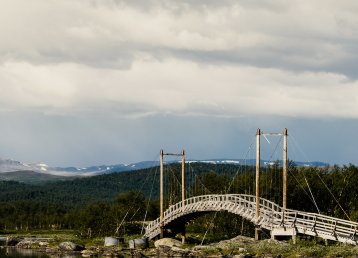My stomach tingles a little as I approach our guide Kerstin from Ofelaš Icelandic Horses. I haven’t sat on a horse for thirteen years. Last time I rode, I was thrown off and broke my pelvis in three places.
– But that won’t happen this time, Kerstin promises. Icelandic horses are calm and friendly, and our horses have a lot of patience with inexperienced riders.
With Ofelaš, you spend time with your horse from the start, meaning that we collect them from the paddock, groom them, pick their hooves and add the packing before the tour begins. We’re off out on a short day trip, so the saddlebags are not as full as they usually are. To prepare the horse beforehand is a good way of getting to know each other. I chat with my horse a little, scratch him in places I remember horses usually like, and soon we’re good friends.
Up in the saddle
Ofelaš keep horses in many locations throughout the Kiruna mountains. Later today they’re taking another couple of horses on a boat across the Kalix River because their popular weekly mountain tours start from the south side of the river. But we’re in Nikkaloukta, right at the foot of the mountains. The sun is shining, the coffee pot stowed in the saddlebag and the horse and I are both keen on adventure.
We’re a small group today; normally 6–8 people join the day trips, but larger groups are no problem. This time it’s just me, Kerstin our guide, and Carl-Johan, the photographer. He’s never ridden a horse in his life, and his nervousness makes me forget my own. All of a sudden, I’m on the horse’s back and feel the familiar movements of the animal underneath. And I’m not nervous anymore! Only excited and happy that I’m about to experience the mountain world on horseback. Before leaving, we try to explain to Carl-Johan how to manage a horse. He’s a reindeer-herding Sámi and used to snowmobiles and quads in this kind of terrain, but he’s never tried it on horseback. Kerstin says a snowmobile probably comes the closest, that the theory of steering is more or less the same for both means of transport.
– You use your body. You push on with legs and seat, help by leaning when you go up- and downhill. The horse will soon feel what you want to do.
Wildlife
Kerstin has herded her reindeer on horseback many times. She says it works surprisingly well. The reindeer are curious about the horse and you can get closer to the heard. Once she was out herding and suddenly found a wolverine underneath the horse she was sat on.
– I think it was as surprised as me, Kerstin laughs. Wolverines usually shy away from the man. You do get a lot closer to most wild animals on a horse. In winter we run elk safaris on horseback and those tours are very popular because you can get so close. The elk is calm and stays at rest even with all the people nearby.
We walk along the water for a while. It shimmers turquoise and the autumn colours are starting to show among the trees. We still have some distance to go until we get to the really great views, but it’s already stunningly beautiful. After a while, Kerstin says it’s time to start tölting. Most of you probably know that Icelandic horses have four and sometimes five different gaits, different to most other breeds. The tölt and the flying pace are the extra gaits and you’ll soon notice if your horse is tölting. It feels like being sat in a rocking chair: you kind of softly rolling along the path. You need to work with your butt to get the horse tölting.
Not like driving a snowmobile
– This isn’t like driving a snowmobile at all! Shouts Carl-Johan behind me.
He’s struggling a bit trying to get the horse into the proper gait, and the jolts are pretty bad for an inexperienced rider. But soon all three softly roll across the land, into the mountains.
We cross a few streams on our way, some of them quite deep. I worry the horse will stumble over the big rocks in the stream, but they cross calmly, safely, and seem to have full control over their hooves. They appear to be skilled in this kind of terrain. Now that we’re riding in the mountains, the ground is mostly moss. In places, we have to cross soft marshland or get through stands with bushy dwarf birches and junipers, but the horses keep going, safely and securely.
I’ve hiked in the mountains before and been amazed by the magnificent landscape. It doesn’t matter how many times you’ve been to the Swedish mountains: standing there surrounded by high, black mountains with white patches of snow makes your stomach tingle – they rise above you almost like killer whales. This time I’m travelling towards Kebnekaise on horseback, and I get a feeling of the American wilderness. Are we really in Swedish Lapland still? It feels a bit different somehow, approaching Sweden’s highest mountain on horseback.
Kebnekaise as backdrop
Kebnekaise is our backdrop when we take a break after a couple of hours. We sit down by a stream, and even if the horses might deserve the break more, my body does feel a bit tender. Those who think that riding is ‘just being sat on a horse’ are mistaken – riding can be compared to high-intensity exercise and even if we’ve mostly kept an easy pace Carl-Johan. I agree that our bodies will probably suffer in the morning. But it’s worth it! We tie the horses to a couple of small, knotty birches, remove their bridles and put halters on so they can munch the oats Kerstin has brought for them. We sit down, and Kerstin makes a fire so we can have some coffee. Nowhere in Swedish Lapland is without coffee, and coffee made over an open fire is one of my favourites. The saddlebags also contain sandwiches, cinnamon buns and another favourite flavour from Swedish Lapland: dried reindeer meat. I carve some slices while Kerstin makes coffee using water from the stream. Then we sit around the fire for a while, chatting about this and that. I ask Kerstin about Ofelaš and life on horseback: does she ever ride out just for fun?
– Oh, yes, I still love riding. Even if it’s what I do for a living, and have done for many years, and even if riding for fun is more about getting a horse into even better shape, or to practise and work on something in particular.
Ofelaš
Ofelaš means ‘guide’, and that’s what Kerstin sees herself as. She and her husband, who also works for Ofelaš, see it as their task to show nature as it is and as it has been since the time of their Sámi ancestors. It must be done with respect, and with as little impact on nature as possible. That’s why Ofelas has been an approved ecotourism organiser since January 2004, awarded the quality label Nature’s Best.
We get to see for ourselves how near you can get to wild animals travelling by horse just a little bit later.
Only a little bit afterwards we can see for ourselves how near you can get wild animals travelling by horse. A magnificent reindeer specimen – a sarv, or male reindeer – comes closer and closer. He’s got enormous antlers, the rut is yet to come, and now he’s curious about the horses. He grazes in circles around us, slowly approaching. But all of a sudden a group of hikers show up. They speak and laugh loudly, and the reindeer takes a couple of mighty leaps to get away and disappears.
The scenery
I walk down to the water and have a good drink. The sun takes its toll on me as well as the horses, and it’s important to get plenty of liquid. It’s so beautiful here; I can’t tire of the mountains. I want to experience it properly on horseback now, perhaps taking a week-long tour? You need proper riding experience to go on the longer mountain tours on horseback, but there are also shorter weekend and overnight trips that are suitable for beginners. On those tours Ofelas bring packhorses, and you sleep in Sámi tents, eating outside by the fire. Sámi culture is always present, in the food and the knowledge passed on by Kerstin and Mats. The tours go to places where you only rarely come across other tourists, giving you that feeling of wilderness that I had a brief glimpse of on the way here.
We put the bridles back on and turn back home, but not the same way as we came. We speak of the horse as a working animal, about the old foresters who used horses in their work back in the day. They were replaced by machinery – men as well as horses. Kerstin stops by a stream to fill one of her saddlebags with angelica, as much as there’s space for. You have to balance the saddlebags, so they both weigh the same, it’s more comfortable for the horse, and the rider. She changes things around a little to make space for the angelica. It can be used for a lot of things: as a tea, in salads, as a sweet and as medicine. The plant actually contains oestrogen, and Sámi women used it against menopausal symptoms in the past.
Friends
After picking the herbs we ride on into the mountain forest, down onto wider forest roads where the horses can tölt and stretch out a little. We also come across more hikers; the area around Nikkaluokta is popular in autumn and many hiking trails start from here. Everyone greets us and the horses with a smile.
After four hours I slide off the horse, that’s it for this time. Carl-Johan walks a bit like Zeb Macahan from the old TV-series, wide-legged as if the horse were still there, underneath. I probably look just as funny. We untack, brush the horses down and lead them back to their pasture. All three lie down to have an enjoyable roll-around in the sand. They are a bit sweaty after the tour, just like us humans. I give my friend Hvellur’s fringe an extra scratch and say thank you for now. I hope to see you again at some point.
Learn more
Ofelaš Icelandic horses are situated 25 kilometres outside Kiruna, with a spectacular view of the mountains and the Kalix river. They offer horse-riding along the mountains both summer and winter, both long a short tours. Visit ofelas.se for more information. If you’re planning to visit Icehotel in winter, you can book Ofelaš northern lights tours on horseback via them.





























